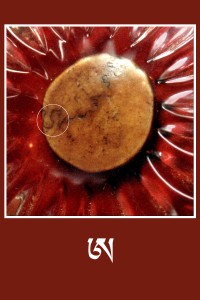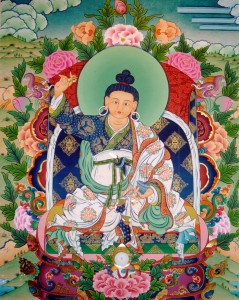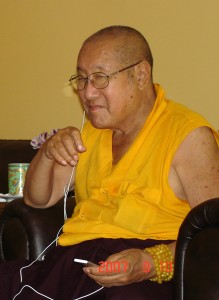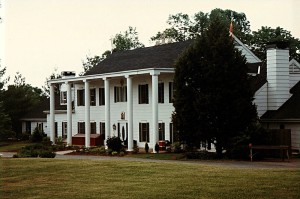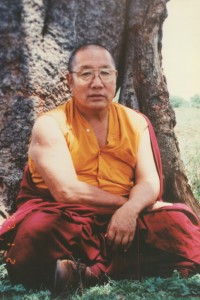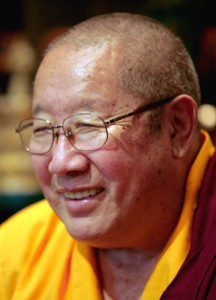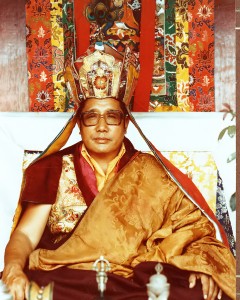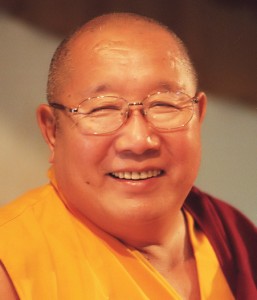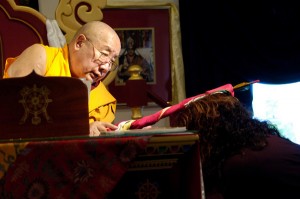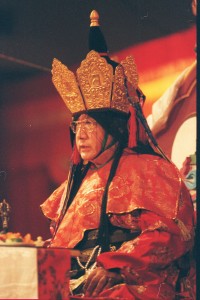
The following is respectfully quoted from “How to Follow a Spiritual Master” as translated by the Ngagyur Nyingma Institute:
H. H. Pema Norbu Rinpoche, an emanation of Pundit Vimalamitra, was born in the twelfth Tibetan month of Water Monkey Year 1932 at Powo in Kham, Eastern Tibet. His father’s name was Sonam Gyurme and his mother Zom Kyid. At the time of his birth, sweet scented flowers miraculously bloomed in his village where no flowers usually appear in the cold and dry winter month. He was recognized as the Third Drubwang Penor Rinpoche through the prophecy of the Thupten Choekyi Dorje, the fifth Dzogchen Rinpoche.
In the upper region of sacred Powo,
At the foot of a majestic hill,
Surrounded by beautiful trees and lakes,
With large rivers flowing from the south,
To a couple bearing names, Sonam and Kyid,
A noble child will be born in the Water Monkey Year,
Possessing great qualities, he will benefit the doctrine and beings.
I the fifth Dzogchen prophesy this.
Khenpo Ngagchung, a prominent Dzogchen adept of the time, foreseeing the exceptional destiny of the new incarnation, gave him the refuge vow and empowerment of Manjushri, a sacred statue and composed a long life prayer used by thousands of his followers around the globe today. Penor Rinpoche was brought when he was five to the Palyul Monastery, the seat of his previous incarnations and was enthroned by Thupten Choekyi Dawa and Karma Thegchog Nyingpo as the incarnation of the Second Drubwang Penor Rinpoche and was the eleventh throne holder of the Palyul tradition.
Palyul Namgyal Jangchub Choeling, one of the six great Nyingma Monasteries, was established under the patronage of Lachen Jampa Phuntsog, the King of Dege and Trichen Sangye Tenpa in 1665.
Rigzin Kunsang Sherab, a prominent Dzogchen master and Terton prophesied by Guru Rinpoche became the first head of the monastery. He was a close disciple of Mahasiddha Karma Chagme and Terton Migyur Dorje, who discovered the Namcho Cycle. Both through the influence of his masters and his own inspiration, the monastery grew rapidly into one of the largest in Tibet. In the following centuries, Palyul often referred to as “the Glorious Palyul of the East”, became the famous center of ardent learning and practice under the guidance of successive throne holders. Hundreds and thousands of monks attained the rainbow body or other spiritual accomplishments from there. Penor Rinpoche was to oversee this large monastery comprising more than four hundred branch monasteries and over three hundred thousand monks and nuns.
Penor Rinpoche spent his early youth in Palyul and Dago, studying and receiving teachings from many masters including Karma Thegchog Nyingpo (the Tenth Throne holder) who prepared him to become the eleventh throne holder. When, as a small child, he was playing with a precious Vajra, he accidentally dropped it, breaking it into pieces. Fearing that his teacher would reprimand him, he quickly glued it back together with his own saliva, making the Vajra stronger than ever. On another occasion, he accidentally dropped a fragile ritual bell on the stone floor. Everybody present assumed that the bell had broken, and yet when Rinpoche picked it up, the bell was as whole and the ring more melodious.
One day when Rinpoche was a small boy, and old man who insisted that Rinpoche practice phowa on him approached him. Rinpoche innocently complied with the old man’s request. To his dismay, he realized that he had actually killed the old man. He immediately practiced again to revive the corpse that lay before him. To Rinpoche’s utter relief, the old man came back to life and said, “For heaven’s sake, why did you call me back? I was already in the pure land of Lord Amitabha.”
Another incident illustrating Rinpoche’s extraordinary power at a tender age occurred when he left his footprints permanently etched in a stone. This incident among others testifies to the karmic continuity of Rinpoche’s former practices. Penor Rinpoche also used to make intricately woven knots in a blessing cord using only his tongue.
Among his numerous masters, Penor Rinpoche benefited immensely from a very warm and close relationship he enjoyed with his master Thupten Choekyi Dawa. At the age of thirteen, he received novice ordination from him, at twenty-one full ordinations and a vast number of teachings including essential instructions and empowerments from the Nyingma tradition. Despite his old age and poor eyesight, his master said, “If I am not able to give the entire teachings, instructions and empowerments to Penor Rinpoche, then I would not have lived my life.”
Penor Rinpoche then underwent a long-term retreat with Thupten Choekyi Dawa at Darthang. Beginning from preliminary practices to the most profound esoteric teachings of Dzogchen, he stressed every practice until naked truth was revealed to him. His Holiness Dilgo Khyentse once said,
“Penor Rinpoche is a saint who has transcended the boundary of samayas”.
Khenpo Jigme Phuntsog repeatedly applauded him as an enlightened Buddha in flesh and blood.
During an accomplishment ceremony (Drubchen), many monks saw a rainbow appear around the mandala and amrita boiled in the skull cup. While conducting the accomplishment ceremony of Magon, the ritual cake of Dakinis was seen shaking vigorously. One day while receiving Kangyur transmissions, Penor Rinpoche had a recollection of Lord Buddha seated at the bank of a river giving profound teachings to him and thousands of others.
According to Khenpo Ngagchung, Penor Rinpoche is also a manifestation of Vajrapani. Rinpoche’s recollection clearly indicates that he had sat at the feet of the Enlightened One in a previous lifetime in the form of Vajrapani.
It was a dream of every Tibetan to make a pilgrimage to Lhasa, especially to see the famous Jowo. In 1956, at the age of twenty-four, Penor Rinpoche with a large entourage began to travel to Central Tibet. There they visited numerous monasteries, ancient temples and sacred places, which revealed the sanctity and glory of Tibet’s past. He also visited His Holiness the Dalai Lama at his winter palace, the Potala and received a long life empowerment. Lhasa Monlam Chenmo was in progress and he offered tea and money to the entire assembly of monks. By then the situation in Lhasa was very tense. With a heavy heart, Penor Rinpoche returned to his monastery in Palyul.
Foreseeing the irreversibility of the Chinese occupation and the threat this would pose to the very existence of the Buddha dharma, Penor Rinpoche and three hundred others fled together to the North Eastern Frontier of India. Only thirty people reached India. Many died at the hands of the Chinese. The journey was a long and a dangerous one. Bullets would fall at Penor Rinpoche’s feet sending clouds of dust. Hand grenades would fall at his feet and when he had moved to a safer distance, they would explode. To survive, people with him would kill animals for food. Penor Rinpoche could not see innocent animals being butchered. Therefore he use to walk ahead and drive away those possible victims. He reached Pema Koe in the Indian state of Arunachal Pradesh with his group and in 1961, moved to South India in Mysore with approximately six hundred people.
The purpose of Rinpoche’s escape from Tibet was to keep the flame of Buddha dharma alive so that beings would not plunge into the darkness and gloom of ignorance. Keeping this in mind, Penor Rinpoche re-established the great Palyul Monastery, Thegchog Namdrol Shedrup Dargyeling in Bylakuppe, Mysore. Rinpoche had at his disposal only a paltry sum of three hundred rupees to rebuild his entire life and that of his monastery. Rinpoche had, however, insurmountable hidden resources – his enormous courage and determination.
People around him did not see the vision that he had and therefore insisted he reduce the size of his planned monastery. At that time, there were only a handful of monks. When later monks by the hundreds crammed into the monastery and found no place to sit, one can only wonder at the foresight that Penor Rinpoche had three decades ago. Few masters of Penor Rinpoche’s status would have undergone the hardships that he went through. In the hot scorching sun, he would carry bricks and sands and would work the cement, his hand bleeding and full of sores. Lack of water and motor roads made the construction even more difficult. Penor Rinpoche had to fetch water from the river that runs by the side of the monastery.
At times during the working day, he and his monks did not mind mixing dirty river water with tsampa. In the early days of settlement, he lived in a tent making Tibetan tea with cheap cooking oil, as he had no butter, and drinking out of a tin can. Rinpoche even cut his zen to share it with another lama. An old woman found him one day digging sewage alone in a deep trench for one of his monks staying in retreat.
One day a man arrived at the site where Rinpoche was working with the group of monks under the sun, he briskly walked up to Rinpoche and said, “I have come a long way to see Rinpoche. May I see him?” “Oh! Sure, why not?” replied Rinpoche. He then took his visitor to his humble room and asked, “Yes, what can I do for you?” The man was both surprised and embarassed. He never expected Rinpoche to be so earthy and accessible. His idea of Penor Rinpoche was different, a well dressed monk on a high luxurious throne. But Rinpoche appeared as a true gem lying on the common soil upon which he himself toiled.
Year after year, Penor Rinpoche with inexhaustible energy and commitment, trudged steadily along the path of progress, undeterred by the numerous obstacles and hardships. The energy that Penor Rinpoche invested was not spent in vain and has borne him abundant fruits. Today Namdroling monastery in Bylakuppe, with over four thousand monks and nuns can bost of being the largest Nyingma monastery in the world. Penor Rinpoche established the Ngagyur Nyingma Institute in 1978 unable to bear the sight of priceless Nyingma doctrine at stake. The NNI, which is now a renowned center for advanced Buddhist education and research studies, has become a special pride for Penor Rinpoche.
Namdroling monastery also hosts a retreat center where several dozen undergo intensive three-year retreats. Penor Rinpoche personally instructs them on the Dzogchen Longchen Nyingthig cycle and Namcho Cycle of Terton Migyur Dorje. Every three years, a large group of Vajracharyas comes out of the retreat. Each year, Rinpoche also gives instructions on Ngondro, Tsalung, and Dzogchen during a month long retreat undertaken by a large number of monks, nuns and lay people. Studies are always coupled with practice and therefore Penor Rinpoche’s monastery is an ideal place for both intensive study and practice. That was Penor Rinpoche’s dream and that is what he still emphasizes today.
Over eight hundred small monks go to the primary school where they are taught basic reading and writing both in Tibetan and English. They also learn basic monastic duties and primary Buddhist teachings. Senior students from the institute teach these young monks. In 1993, Penor Rinpoche also founded Tsogyal Shedrubling Nunnery where over five hundred nuns study and practice and a home for the elderly where thirty people live and practice. These elders can be seen with their prayer wheels and malas, either sitting under the trees or circumambulating the sixteen large stupas that Penor Rinpoche built and dedicated to world peace.
The compassion of Rinpoche also extends to the local Indian people too. He has constructed many roads and bridges to benefit people. The money that he receives in the form of donations is always spent on worthy causes, such as the above named projects. While both in India and Tibet, Penor Rinpoche is also famous for making timely rain when the seasonal rainfall does not fall. The local Indians have nick named him, “The Rain Lama”.
Penor Rinpoche has given the entire Rinchen Terzoed Empowerments six times and the Nyingthig and Namcho Cycles several times more. He was the first Tibetan Master to give Rinchen Terzoed in the West. Rinpoche is looked upon by so many as having an infinite variety of skills and capacities. To his followers, especially to his beloved monks, he is more than a father, doctor, psychiatrist, therapist, healer, and teacher.
Being a peerless full-fledged monk himself, Penor Rinpoche has given ordination to thousands of monks and nuns. Apart from the teachings and empowerments he dispenses, he provides solutions to various human problems. Day in and day out, he selflessly works for the benefit of the living and dying or dead. The marvelous activities of His Holiness are expanding exponentially. During his four return visits to Tibet since 1959, he renovated the mother Palyul Monastery and its numerous branch monasteries. He further established new dharma centers in the Himalayan region as well as Hong Kong, Taiwan, Singapore, Malaysia, and the Philippines. There are also centers in the USA and Europe. Rinpoche travels tirelessly throughout India, the Himalayas, South East Asia and the West bestowing teachings and empowerments to his countless disciples.
The representatives of the Nyingma Buddhists around the world unanimously appointed Rinpoche in 1993 during the Nyingma Monlam Chenmo under the Bodhi Tree at Bodh Gaya. He assumed responsibility and title formerly held by His Holiness Dudjom Rinpoche and Dilgo Khyentse Rinpoche.
His recent visible achievements are too numerous to list fully, not to mention the full spectrum of his hidden activities for the benefit of beings, may it be his countless disciples or all sentient beings.
The below mentioned are some of his main achievements. He established among other an imposing, beautifully decorated New Temple in Bylakuppe, able to accommodate several thousand monks and nuns. The sheer majesty of this building as well as the enormous size of the three statues of the Lord Buddha, Guru Rinpoche and Buddha Amitayus, covered in gold leaf, the extensive collection of thangkas masterpiece gracing every wall, the ornate wooden carvings have prompted the numerous Indian visitors to name it the Golden Temple. However, Rinpoche insists in saying that he has not build any golden temple yet, a feat he is currently achieving with the new project of building Sando Pari — Guru Rinpoche’s Paradise — on the site of the first temple recently brought down. The current “Golden Temple” was inaugurated amidst sumptuous celebrations and many auspicious ceremonies in the presence of His Holiness the Dalai Lama and thousands of monks, nuns and invited guests on September 23rd 1999.
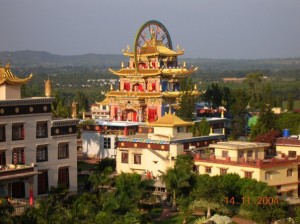
In New York State, in a beautiful quiet environment of the Catskills, Rinpoche founded the seat of his work in the USA, a retreat center complete with all facilities, a fully decorated Temple with statues and religious paintings where he bestows annually the whole retreat cycle of the Palyul tradition to his disciples coming from America, Europse and other Asian countries. There are rooms and outdoor accommodations for retreatants. There are also numerous students who have now offered centers to Rinpoche throughout the whole of the North American continent as well as Canada, which Rinpoche visits every year and where he bestows Teachings, Empowerments and advice to his rapidly growing number of followers.
In Mysore, he is also currently completing the building of a large hospital equipped with the latest facilities to serve the needs of a rapidly expanding community of monks, nuns, children and local people. Rinpoche finds every year extraordinary resources to provide absolutely all that is needed to accommodate, feed, cloth, educate and guide in the purest spiritual tradition all his followers and buildings are springing forth in a near uninterrupted stream to keep up with the expansion of his activities. Surrounded by over seventy tulkus whom he has recognized and enthroned, he dispenses generously whatever is needed, and well beyond to all his followers, ordained and lay people alike, upholding the purest vinaya tradition as a great unassuming Enlightened Bodhisattva.
